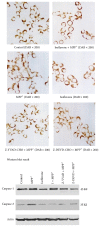Isoflavone Attenuates the Caspase-1 and Caspase-3 Level in Cell Model of Parkinsonism
- PMID: 26161002
- PMCID: PMC4487343
- DOI: 10.1155/2015/725897
Isoflavone Attenuates the Caspase-1 and Caspase-3 Level in Cell Model of Parkinsonism
Abstract
The study has investigated the effect of isoflavone attenuates the caspase-1 and caspase-3 level in cell model of Parkinsonism. The subjects were PC12 cells. They were randomly divided into six groups: control, MPP(+) (250 μmol/L), isoflavone (10 μM), isoflavone (10 μM) + MPP(+) (250 μmol/L), Z-YVAD-CHO (10 nM) + MPP(+) group, and Z-DEVD-CHO (10 nM) + MPP(+) group. Cell viability was measured by MTT methods; the content of tyrosine hydroxylase was measured by immunocytochemistry method of avidinbiotin peroxidase complex; apoptosis ratio was measured by flow cytometry. The results showed that cell viability in the MPP(+) group was lower than in all other five groups. There was no difference in cell viability between isoflavone + MPP(+) and control group. Optical density of TH positive cells in isoflavone group was higher than in control, isoflavone + MPP(+), and MPP(+) only groups. The apoptosis ratio in the isoflavone + MPP(+) group and control group and the Z-YVAD-CHO + MPP(+) and Z-DEVD-CHO + MPP(+) group was similar, which was lower than in the MPP(+) group. The lowest apoptosis ratio was found in the isoflavone only group.
Similar articles
-
Implication of the c-Jun-NH2-terminal kinase pathway in the neuroprotective effect of puerarin against 1-methyl-4-phenylpyridinium (MPP+)-induced apoptosis in PC-12 cells.Neurosci Lett. 2011 Jan 3;487(1):88-93. doi: 10.1016/j.neulet.2010.10.002. Epub 2010 Oct 8. Neurosci Lett. 2011. PMID: 20934486
-
Protection by puerarin against MPP+-induced neurotoxicity in PC12 cells mediated by inhibiting mitochondrial dysfunction and caspase-3-like activation.Neurosci Res. 2005 Oct;53(2):183-8. doi: 10.1016/j.neures.2005.06.014. Neurosci Res. 2005. PMID: 16112764
-
Protective effect of estrogen on apoptosis in a cell culture model of Parkinson's disease.Clin Invest Med. 2008 Oct 1;31(5):E258-64. doi: 10.25011/cim.v31i5.4872. Clin Invest Med. 2008. PMID: 18980715
-
Morin exerts neuroprotective actions in Parkinson disease models in vitro and in vivo.Acta Pharmacol Sin. 2010 Aug;31(8):900-6. doi: 10.1038/aps.2010.77. Epub 2010 Jul 19. Acta Pharmacol Sin. 2010. PMID: 20644549 Free PMC article.
-
[Neuroprotective effects of paeonol in a cell model of Parkinson disease].Zhejiang Da Xue Xue Bao Yi Xue Ban. 2015 Jan;44(1):30-6. doi: 10.3785/j.issn.1008-9292.2015.01.005. Zhejiang Da Xue Xue Bao Yi Xue Ban. 2015. PMID: 25851972 Free PMC article. Chinese.
Cited by
-
Coumarin-chalcone derivatives as dual NLRP1 and NLRP3 inflammasome inhibitors targeting oxidative stress and inflammation in neurotoxin-induced HMC3 and BE(2)-M17 cell models of Parkinson's disease.Front Aging Neurosci. 2024 Oct 1;16:1437138. doi: 10.3389/fnagi.2024.1437138. eCollection 2024. Front Aging Neurosci. 2024. PMID: 39411284 Free PMC article.
References
-
- Li X.-L., Cheng W.-D., Li J., et al. Protective effect of estrogen on apoptosis in a cell culture model of Parkinson's disease. Clinical and Investigative Medicine. 2008;31(5):E258–E264. - PubMed
Publication types
MeSH terms
Substances
LinkOut - more resources
Full Text Sources
Other Literature Sources
Research Materials



